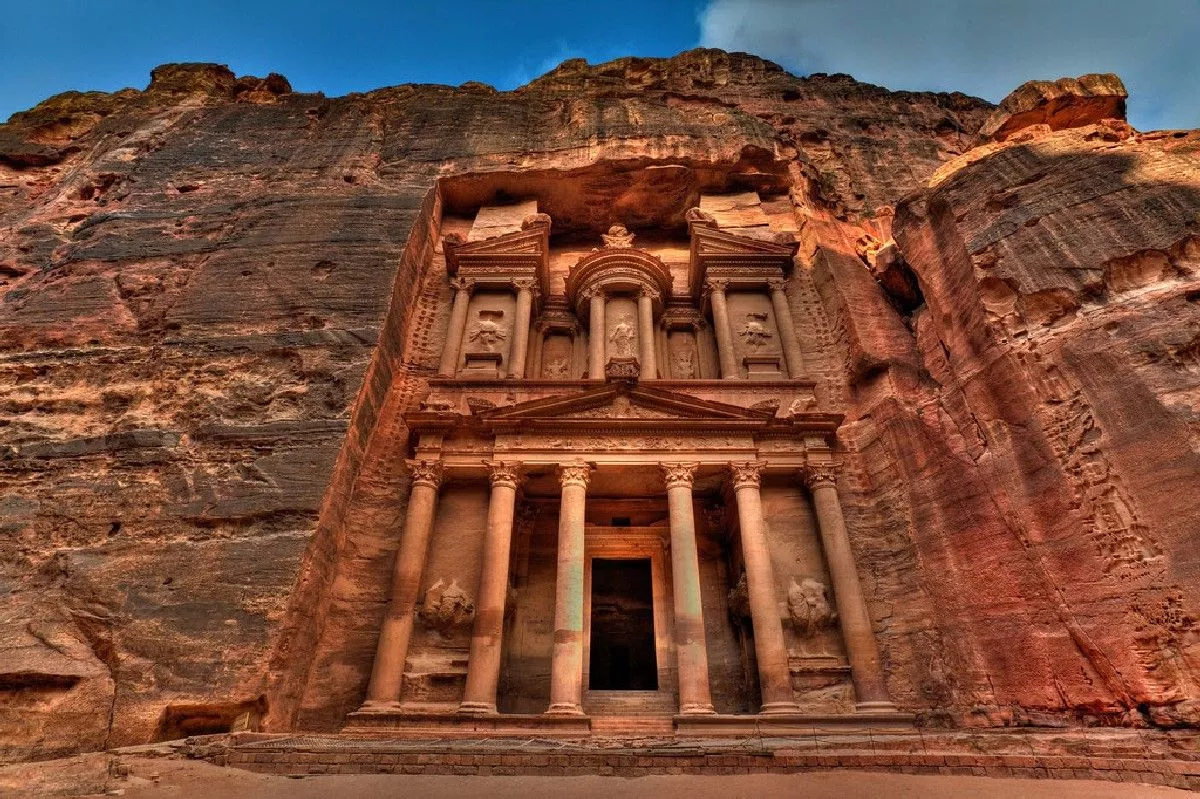City of Petra Travel Guide

The highlights of the ancient city are good. The Siq canyon, which is echoed as you walk through it, precedes an awe-inspiring encounter with the Treasury, Petra's iconic facade carved directly from the cliff face. The large Theatre is past the Royal Tombs, which overlook the hidden valley where the city center is situated. The Monastery is one of Petra's most significant monuments, carved from a mountain summit, where you can spend some time. You may also walk down Colonnaded Street to Qasr al-Bint temple, which provides spectacular sunset views. Walking on sandy (or sometimes rocky) footpaths the entire distance, which would be difficult, gives a full day's worth of incredible sights and experiences. Yet many visitors take even more time.
There are several possibilities for wide-ranging exploration if you stay longer than the usual package tour requires in Petra. A mountain-top altar on the High Place of Sacrifice provides outstanding sights. To go to Wadi Turkmaniyyeh, near the tourist hubbub, you must walk through desolate peaks and wild ravines. Little Petra, a few kilometers away to the north, is a tiny Siq and carved facades, away from the leading site, that hides a mini-Siq and carved facades of its own. It's challenging to get in and out of Petra, located in a valley between two chains of sharp peaks, and you must pass through the modern town of Wadi Musa to the east. In recent decades, Wadi Musa has grown to serve the substantial tourist trade to Petra, and it has everything, including restaurants and hotels. There is no place to stay in the ancient city and few places to eat. The single entrance gate into Petra is in Wadi Musa, but once you've crossed that barrier, you're immediately thrown into the rocky landscape of the desert. There is no urban development within Petra, and the local culture is all rural.
Brief history of Petra

The history of Petra stretches back over one hundred centuries and includes rock, a Greek word for stone. Petra, a pre-historic village, was once inhabited by hunter-gatherers. The inhabitants of Beidha, just north of Petra, lived in walled farming villages about nine thousand years ago. The development of Petra took place over millennia due to the ancient civilizations of Mesopotamia and Egypt attempting to contact one another. Several millennia after nomadic tribes traversed the region, a caravan route was sought to cross the high Sinai Mountains to Egypt and the Naqab (Negev) to Gaza. Petra, where abundant springs tumble down into the Wadi Araba through a natural fault in the mountains, was a prime choice, marking the spot on the north–south King's Highway where an east–west passage could connect the two empires.
Petra's golden age
In the first centuries BC and AD, Petra peaked, with a population of as many as thirty thousand residents. Strabo described the city as wealthy, cosmopolitan, and full of delicate structures, villas, watercourses, and gardens, frequented by Romans and foreigners and ruled by a democratic monarch. Strabo reported that the Nabateans honor those who increase their property and punish those who lose it.
However, the writing was clear. The monsoon winds were disrupting trade routes, causing a shift from land to sea routes. Furthermore, Rome diverted trade away from Petra in favor of Egypt and Syria, foreshadowing the future rise of Palmyra. Because of this, the Nabateans were being pressured. King Rabbel II of Nabatea moved his capital from Petra to Bosra to avoid Roman invasion, but he was forced to submit to Roman demands. Roman forces took control of the Nabatean kingdom in 106 AD after Rabbel's death.
Petra colors:
One of the most breathtaking aspects of Petra – for many people surpassing even the architecture – is its colorful sandstone, famously celebrated in a particular tourist's memoirs almost 150 years ago. As the artist Edward Lear strolled up the Colonnaded Street on a visit in 1858, coolly noting "the tint of the stone… brilliant and gay beyond my anticipation", his manservant and cook, Giorgio Kokali, burst out in delight, "Oh master, we have come into a world of chocolate, ham, curry powder and salmon!"
Agatha Christie, who visited in the 1930s, preferred to see the rocks as "blood-red." A character in her Appointment with Death, set in Petra, comes out with a line describing the place as "very much the color of raw beef."
Unfortunately for posterity, however, the most famous lines in Petra's colors are less engaging. In 1845, John William Burgon, later to become Dean of Chichester, wrote in his poem, Petra:
It seems no work of Man's creative hand,
By labor wrought as wavering fancy planned;
But from the rock, as if by magic grown,
Eternal, silent, beautiful, alone!
Not virgin-white like that old Doric shrine,
Where erst Athena held her rites divine;
Not saintly grey, like many a minister fane,
That crowns the hill and consecrates the plain;
But rose red as if the blush of dawn
That first beheld them were not yet withdrawn;
The hues of youth upon a brow of woe,
Which Man deemed old two thousand years ago,
Match me such a marvel save in Eastern clime,
A rose-red city is half as ancient as Time.
No advertising copywriter could have dreamt up a better final line, and Burgon's words have hung over Petra ever since. You'll be sick of reading "rose-red city" on every map, poster, and booklet by the time you leave. Tellingly, Burgon had never been to Petra when he wrote it; he finally went sixteen years later and at least then had the humility to write, if only in a letter to his sister, "There is nothing rosy about Petra."




















